Ode to a Fiddlehead…
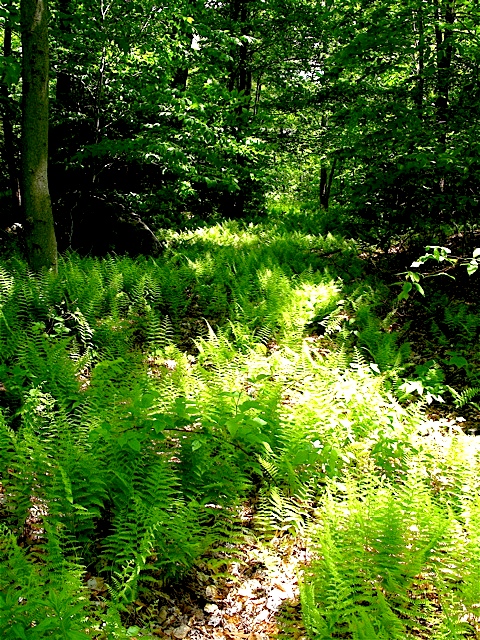 The woodland path at Ferncliff – Image â“’ Michaela Medina – The Gardener’s Eden
The woodland path at Ferncliff – Image â“’ Michaela Medina – The Gardener’s Eden
Call me a fiddle-head, it is true. I have a long standing love-affair with ferns. Ostrich and Cinnamon, Maidenhair and Lady, Autumn and Christmas; even their names delight me, and I can never seem to get enough of this delicate, feathery species. My affection can be traced back to the summers of my childhood; those long, hot afternoons and fading twilight hours spent exploring abandoned stone foundations and hidden brooks in the forest beyond my home. There, beneath the shade of tall trees, ferns became woven crowns and verdant skirts fit for imaginary forest royalty. To my eye, when it comes to beauty in the plant world, foliage truly equals flower. What could be more beautiful than the fern? Shimmering, silver fiddleheads unfurling from damp earth, luminous feather paths winding through dark tree-trunks, and lacy plumes softening rugged outcroppings of rock and ledge; ferns possess some of the most dramatic foliage in the forest.
Native to North America, the cinnamon fern, (Osmunda cinnamonea, pictured below), is a perfect example of the long-lasting beauty of this foliage plant. In very early spring, the fuzzy, silvery-white tipped fiddle-heads of cinnamon fern emerge from the forest floor. As the first tightly wrapped heads unfurl, (reaching upward 2-4 feet), they quickly transform into stunningly beautiful, rich cinnamon stalks, followed by rapidly emerging, bright green fronds. By midsummer, the foliage of the cinnamon fern deepens to a regal emerald hue. Later, in autumn, the bold foliage turns a brilliant gold that absolutely glows in the forest. As lovely as it is in a natural setting, the cinnamon fern is also a spectacular addition to the garden. This non-aggressive plant forms thick but contained clumps of growth. As a companion to spring flowering bulbs, and a contrast to the exfoliating bark of trees, (river birch, stewartia and paperbark maple spring to mind), the design possibilities of both the lush foliage and cinnamon-colored stalks make the cinnamon fern one of my favorites.
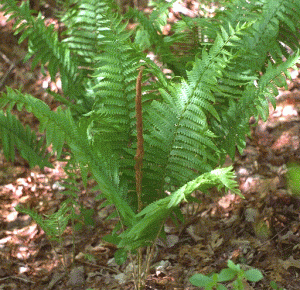 Cinnamon Fern (Osmunda cinnamonea) – Image: Georgian Court University
Cinnamon Fern (Osmunda cinnamonea) – Image: Georgian Court University
Cinnamon fern’s close relative, the interrupted fern, (Osmunda claytonia), is another gorgeous native plant. As the fiddle-heads unfurl to a height of 2-3 feet, the foliage on this fern’s upright, fertile fronds is interrupted midway by sporing pinnae. This break gives the plant its common name, ‘interrupted’ fern. The non-sporing fronds arch away from the plant dramatically, creating an attractive, flowing green mound. Interrupted ferns prefer slightly damp conditions, where they forms natural groupings in the wild. As a garden plant, the interrupted fern is endlessly useful in dappled light and partly sunny conditions. Though large, the airy fronds of this fern combine well with many trees, shrubs and perennials.
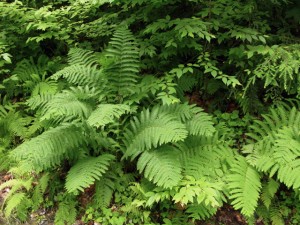 Interrupted Fern (Osmunda claytoniana)
Interrupted Fern (Osmunda claytoniana)
The Christmas fern, (Polystichum acrostichoides), is an evergreen fern, and one of the most shade tolerant members of this species. Another North American native, this leathery-leafed plant can often be found carpeting steep banks in densely forested areas. As a garden plant, the soil-stabilizing qualities of Christmas fern make it an excellent choice for shady slopes and other places where erosion is a concern. In Northern woodlands, the beauty of this plant’s glossy, deep green foliage is well appreciated in late autumn and early winter, when most deciduous trees have shed their leaves and the forest floor has turned brown.
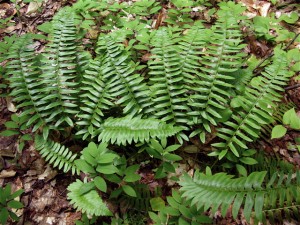 Christmas Fern (Polystichum acrostichoides)
Christmas Fern (Polystichum acrostichoides)
It is easy to understand how the enormous, feathery plumes of Ostrich fern, (Matteuccia pensylvanica, pictured below), earned their name. Â This gorgeous fern is also one of my favorites, and placed with care, it can be a fantastic garden plant. Ostrich fern spreads by aggressive rhizomes, making it useful as a ground cover in damp areas. If planted in a dry spot, (as it is in my secret garden), however, Ostrich fern is mild mannered and easily contained. In it’s ideal conditions, (moist, dappled shade), this fern can reach nearly six-feet in height. And although there is no autumn color, if the plant receives ample moisture, it will remain attractive and green through late autumn.
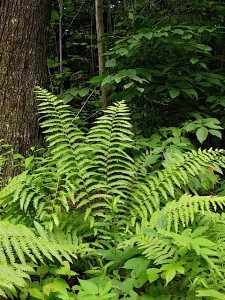 Ostrich Fern (Matteuccia pensylvanica) is a member of the cliff fern family.
Ostrich Fern (Matteuccia pensylvanica) is a member of the cliff fern family.
The delicate and airy, native maidenhair fern, (Adiantum pedatum), and lady fern, (Athyrium felix-feminina), are commonly used in gardens, and with good reason. Both of these plants are not only beautiful but tough, tolerating a wide variety of soil conditions and changing light. Although both ferns prefer dappled shade and moist soil, they will succeed under less favorable circumstances, and need not be coddled. Lady fern in particular has become popular with commercial growers, and it seems a new variety is available whenever I pick up a magazine or catalogue. Beyond the commonly available lady fern, (a member of my favorite group, the cliff ferns), I have come to enjoy the sanguine stems of Athyrium felix-feminina, “Lady in red”, as they emerge along my garden wall.
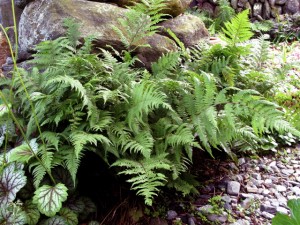 Lady Fern (Athyrium filix-femina) ‘Lady in Red’ and companion Huechera ‘Green Spice’
Lady Fern (Athyrium filix-femina) ‘Lady in Red’ and companion Huechera ‘Green Spice’
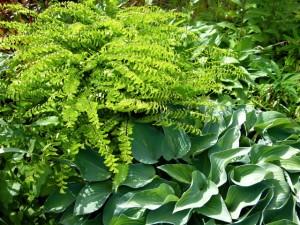 The northern maidenhair fern (Adiantum pedatum) planted with Hosta.
The northern maidenhair fern (Adiantum pedatum) planted with Hosta.
Many of the other ferns native to North America, such as the bracken fern, (Pteridium aquilinum), and hay-scented fern,(Dennstaedtia puctilobula), are lovely in naturalized settings, or singular landscape uses, but are far too aggressive for mixed borders or perennial gardens. Hay-scented fern forms dense carpets, and it is particularly beautiful and useful along woodland paths, hedges, walks and driveways, and beneath dense foliage trees.
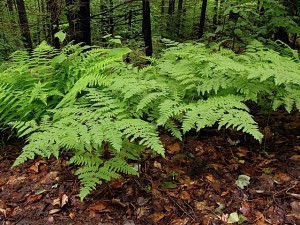 Bracken Fern (Pteridium aquilinum) beautiful in naturalized areas, is an aggressive spreader.
Bracken Fern (Pteridium aquilinum) beautiful in naturalized areas, is an aggressive spreader.
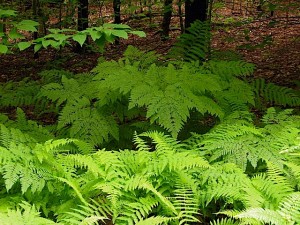 A natural grouping of hay-scented, bracken and interrupted ferns in the forest at Ferncliff.
A natural grouping of hay-scented, bracken and interrupted ferns in the forest at Ferncliff.
In addition to the many ferns native to North America, introduced garden ferns and hybrids, such as the Japanese painted fern, (Athyrium nipponicum, “Pictum”), are spectacular plants for light to dense shade situations. Beautiful, subtle color variations in fern foliage can be played against one another and in combination with other plants to create breathtakingly beautiful patterns. A ground-cover of perennial ferns can become a living tapestry to be enjoyed throughout the growing season, year after year. Athyrium x “Ghost” is a particularly beautiful fern, and I have found the color varies a bit by placement and light. The frosty white fronds are stunning at twilight in darker corners of my garden.
 Athyrium x ‘Ghost’ planted to with Hosta ‘August Moon’ , Astilbe, Lamium and Cryptotaenia japonica
Athyrium x ‘Ghost’ planted to with Hosta ‘August Moon’ , Astilbe, Lamium and Cryptotaenia japonica
 Athyrium nipponicum ‘Pictum’, planted with Cryptotaenia japonica ‘Atropurpurea’
Athyrium nipponicum ‘Pictum’, planted with Cryptotaenia japonica ‘Atropurpurea’
 Japanese painted fern, Athyrium nipponicum ‘Pictum’, nestled beside Hosta and seeded Heuchera ‘Palace Purple’
Japanese painted fern, Athyrium nipponicum ‘Pictum’, nestled beside Hosta and seeded Heuchera ‘Palace Purple’
Having named my garden Ferncliff, it should come as no surprise that I am a true fern-fanatic. When designing gardens here and elsewhere, I am always on the look-out for new ways to use ferns in garden settings. Ferns are remarkably versatile plants; softening formal designs and lending elegance to modest buildings and simple features. Ferns can be planted in urns to flatter classical architecture, or in geometrically precise planters to harmonize with more modern landscapes. The airy quality of ferns provides movement in shady nooks with the slightest breeze, and the textural qualities of fronds enliven the edge of still or slow-moving water features and smooth wall surfaces. The possibilities of ferns are limited only by imagination.
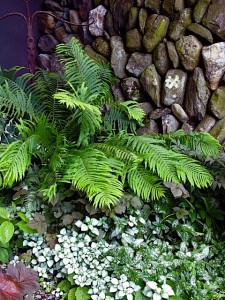 Ostrich Fern, (Matteuccia pensylvanica), softening the edge of the secret garden at Ferncliff.
Ostrich Fern, (Matteuccia pensylvanica), softening the edge of the secret garden at Ferncliff.
For more information on ferns, see Martin Rickard’s The Plantfinder’s Guide to Garden Ferns, (copyright 2000, Timber Press).
Image of Cinnamon Fern: Georgian Court University
Article and all other photographs copyright 2009 Michaela Medina – The Gardener’s Eden